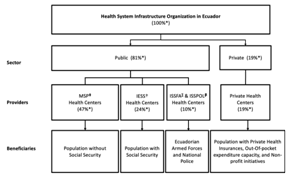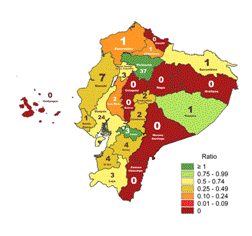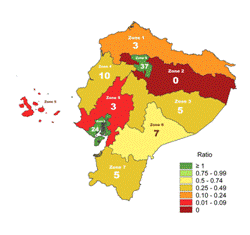Introduction
Neurological disorders are the leading cause of disability and the second cause of death worldwide. In the past 30 years, the absolute number of deaths and people with disabilities owing to neurological diseases has risen, particularly in low and middle-income countries. Further neurological morbimortality increment is expected globally due to population growth, aging (1), and the emergence of the COVID-19 pandemic, which has been associated with neurological complications (2). In the 2016 Global Burden Disease Study, Ecuador reported a 32.8% surplus in disability-adjusted life years attributable to neurological disorders for the last 25 years (3). In 2008, Cruz et al. described Ecuador's neurologic health profile as one displaying significant needs, aggravated by the lack of specialists concentrated in the principal cities, centralism, scarce primary care, and lack of neurology training (4). By the end of that year, the Ecuadorian Government adopted a new constitution focusing on health care rights and social reforms, prioritizing human resources, aiming to decrease the specialists' gap (5). Ecuador's Public Health System [PHS] current objective is to provide efficient and universal free health care coverage. For this, one to five neurologists per 100,000 population should become available (as per the World Health Organization's (WHO) ideal ratio) (6). To our knowledge, no publication analyzes Ecuador's capacity to supply the demand for public neurological health services based on the number of specialists per population ideal ratio or the availability of neurology training programs in the country. Hence, a current description and analysis of the number of available neurologists and neurology training programs in Ecuador's PHS is critical.
Materials and methods
Cross-sectional analysis of public records available up until November 2022 regarding the number of neurologists in the Ministry of Public Health (MSP) and the Ecuadorian Institute of Social Security (IESS) were reviewed; in addition to the official data on available training programs in Neurology per the Government Council for Higher Education (CES). Data from the National Institute of Statistics and Censuses (INEC) population projection was used for the ratio calculation (7). The data was entered and stored digitally in a spreadsheet using Microsoft© Office Excel© 2021 MSO (Microsoft Corporation, USA) program and subsequently exported and analyzed with the Statistical Package for Social Sciences (SPSS) SPSS 23 software. (IBM Corporation, USA).
Results
Ninety-four neurologists were found in Ecuador’s public health network, concentrated in the secondary (n=57/60.6%) and tertiary (n=37/39.4%) levels of care.
The provinces with the highest availability of neurologists were Pichincha 37 (39.4%), Guayas 24 (25.5%), and Manabí 7 (7.4%). Esmeraldas, Imbabura, Pastaza, Santa Elena, and Sucumbíos have one neurologist per province. The provinces with no neurologists are Bolívar, Carchi, Cotopaxi, Galápagos, Morona Santiago, Napo, Orellana, and Zamora Chinchipe (Table 1).
Table 1 Neurologists’ distribution per province
| Province | Neurologists | Population | Ratio† |
|---|---|---|---|
| Azuay | 4 | 881394 | 0.45 |
| Bolivar | 0 | 209933 | 0.00 |
| Cañar | 3 | 281396 | 1.07 |
| Carchi | 0 | 186869 | 0.00 |
| Chimborazo | 2 | 524004 | 0.38 |
| Cotopaxi | 0 | 488716 | 0.00 |
| El Oro | 2 | 715751 | 0.28 |
| Esmeraldas | 1 | 591083 | 0.17 |
| Galápagos | 0 | 33042 | 0.00 |
| Guayas | 24 | 4387434 | 0.55 |
| Imbabura | 1 | 476257 | 0.21 |
| Loja | 3 | 521154 | 0.58 |
| Los Ríos | 2 | 921763 | 0.22 |
| Manabí | 7 | 1562079 | 0.45 |
| Morona Santiago | 0 | 185494 | 0.00 |
| Napo | 0 | 144746 | 0.00 |
| Orellana | 0 | 161338 | 0.00 |
| Pastaza | 1 | 114202 | 0.88 |
| Pichincha | 37 | 3228233 | 1.15 |
| Santa Elena | 1 | 401178 | 0.25 |
| Santo Domingo de los Tsáchilas | 3 | 511151 | 0.59 |
| Sucumbíos | 1 | 230503 | 0.43 |
| Tungurahua | 2 | 590600 | 0.34 |
| Zamora Chinchipe | 0 | 120416 | 0.00 |
| Total | 94 | 17468736 | 0.54 |
*Ratio: Number of neurologists per 100000 population.
The provinces most densely populated were Guayas with 4,387,434, Pichincha with 3,228,233, Manabí with 1,562,079, and Azuay with 881,394.
Regarding the number of neurologists per population ratio: Guayas has one neurologist for every 182,810 people, equivalent to 0.55 per 100,000 people. Pichincha has one neurologist for every 87,250 people (1.15:100,000). Manabí, one neurologist per 223,154 people (0.45:100,000), and Azuay, one neurologist for every 220,349 people (0.45:100,000).
The ideal ratio of one neurologist per 100,000 population is achieved by Cañar, with three neurologists available for a 281,396 population (1.07:100,000), and Pichincha, as previously mentioned, which holds the highest ratio.
The provinces farthest from the ideal ratio are Esmeraldas, with one neurologist per 591,083 people (0.17:100,000), Imbabura with one for every 476,257 (0.21:100,000), and Los Ríos, with one neurologist for every 460,882 individuals (0.22:100,000); not considering the provinces without neurologists, whose ratio is 0:100,000. With a total Ecuadorian population of 17,468,736 and 94 neurologists available in the PHS at the time, the ratio was 0.54:100,000 (Figure 1).
A single neurology training program was found in Quito. This program was approved and accredited by the CES in 2020 and is sponsored by a private university (Universidad De las Americas). The total duration of the program is 48 months and has thirty positions available for postgraduate training. It is self-financed, with a USD 115.00 application fee for selected applicants, a USD 4,600.00 registration fee, and a total tuition of USD 46,000.00. Its training sites are medical centers belonging to IESS, MSP, Police Social Security Institute (ISSPOL), Armed Forces Social Security Institute (ISSFA), and three other private hospitals (Table 2) (8)(9)(10)(11).
Table 2 Neurology Training Program in Ecuador
| Duration | 48 months |
| Accreditation Period | November 21, 2020 - October 21, 2026 |
| Positions available | 30 |
| Financing | Self-financed |
| Registration fee | USD 4,600.00 |
| Tuition | USD 46,000.00 |
| Location | Quito Metropolitan District |
| Training Centers | IESS⨥ - Hospital General San Francisco de Quito |
| ISSFA∑ - Hospital de Especialidades Fuerzas Armadas No. 1 | |
| ISSPOL 𝝱 - Hospital de Quito No.1 Policia Nacional | |
| MSP⋕ - Hospital del Adulto Mayor | |
| MSP⋕ - Hospital Pablo Arturo Suarez | |
| MSP ⋕ - Hospital Especialidaes Eugenio Espejo | |
| MSP ⋕ - Hospital Pediatrico Baca Ortiz | |
| MSP ⋕ - Hospital General Docente Calderon | |
| Private - Solca Núcleo de Quito | |
| Private - Novaclínica Santa Cecilia | |
| Private - Hospital Vozandes | |
| University | Universidad De Las Americas |
| CES* resolution Number | RPC - SO - 23 - No. 502 - 2020 |
| RPC - SO - 33 - No.519 - 2022 |
*⨥, IESS: Ecuadorian Institute of Social Security. ∑, ISSFA: Armed Forces Social Security Institute. 𝝱, ISSPOL: Police Social Security Institute. ⋕, MSP: Ministry of Public Health. *, CES: Council for Higher Education
Discussion
In 2008, Ecuador underwent critical structural changes in the organization of the public health institutions and the constitution towards the goal of providing Universal Health Coverage (UHC) [5,12]. Ecuador's health system comprises two sectors, the public and private (Figure 2). The public sector embodies 81% of healthcare establishments. Its main institutions are the MSP (47%) and IESS (24%), which jointly hold the largest medical infrastructure, followed by the ISSPOL and the ISSFA, representing approximately 10% of the public sector (13)(14). The private health infrastructure services represent a 19%, mainly harnessed by the upper and middle-income populations, who represent approximately 3% of Ecuadorians (5)(15). Therefore, almost 97% of the Ecuadorian population relies on the PHS. Ecuador's 2008 constitution states, "Health is a right guaranteed by the Government" (5)(12). Consequently, in aims to fulfill this goal concerning neurological health, the Ecuadorian Government should match the WHO recommendation of one neurologist per 100,000 population (6).

Figure 2 *Percentage of the Health System Infrastructure in Ecuador. # Ministry of Public Health. ⨥ Ecuadorian Institute of Social Security. ∑ Armed Forces Social Security Institute. 𝝱 Police Social Security Institute
Recently, Rodriguez et al. analyzed the temporal and geographical distribution of medical specialists in Ecuador between 2000 to 2017, showing that the estimated number of neurologists increased from 159 to 220 (16). In this case, the total estimated ratio of neurologists per population is 1.23:100,000. Nevertheless, the Ecuadorian population mainly depends on the PHS (13)(14)(15), whose neurologists’ ratio per population is 0.54:100,000, hence insufficient for providing adequate neurological care. Regarding the geographical distribution of neurologists, our findings correlate with previous studies showing unequal distribution by province (16). Our results showed that 64.89% of the neurologists available in the PHS were found in the two largest provinces (Pichincha and Guayas).
Since 2010, to decentralize public services, the Ecuadorian Government created administrative levels of planning: zones, districts, and circuits to better identify needs and effectively provide public health services in each territory (13). According to the Health System’s zonal divisions, we adjusted our analysis, showing that only Zones Eight (Guayaquil, Samborondon, and Duran) and Nine (Metropolitan District of Quito) achieved the ideal ratio of neurologists per population (Table 3). Paradoxically, this administrative division does not consider users’ accessibility to services (Figure 3), potentially restricting openness to health services. Still, this requires further analysis beyond the scope of this study.
Table 3 Neurologists’ allocation per zones.
| MSP Zones | Neurologists | Population | Ratio |
|---|---|---|---|
| Zone 1: Esmeraldas, Imbabura, Carchi, Sucumbíos | 3 | 1484712 | 0.20 |
| Zone 2: Napo, Orellana, Pichincha† | 0 | 752676 | 0.00 |
| Zone 3: Cotopaxi, Tungurahua, Chimborazo, Pastaza | 5 | 1717522 | 0.29 |
| Zone 4: Manabí, Santo Domingo de los Tsáchilas | 10 | 2073230 | 0.48 |
| Zone 5: Sta. Elena, Bolívar, Los Ríos, Galapagos y Guayas‡ | 3 | 3829895 | 0.08 |
| Zone 6: Cañar, Azuay, Morona Santiago | 7 | 1348284 | 0.52 |
| Zone 7: El Oro, Loja, Zamora Chinchipe | 5 | 1357321 | 0.37 |
| Zone 8: Cantón de Guayaquil, Samborondón y Durán | 24 | 2123455 | 1.13 |
| Zone 9: Metropolitan District of Quito | 37 | 2781641 | 1.33 |
| Total | 94 | 17468736 | 0.54 |
*† Pichincha province except for the Metropolitan district of Quito. ‡ Province of Guayas excluding Guayaquil, Durán and Samborondón.
A possible solution is to boost postgraduate neurological training accessibility. Until 2007, Ecuador had at least five Neurology training programs (17). But in 2008, after the new constitutional framework, the country experienced multiple legal and institutional reforms in higher education and suspended the offer for new positions in postgraduate training (18). Presently in Ecuador, the training programs for medical specialties are offered by medical schools accredited by the Government and supervised by the MSP and CES. In 2014, the Government implemented a standard test to measure the theoretical knowledge of medical graduates wanting to practice medicine in Ecuador. However, the admission system for specialization programs is based on non-standardized tests. Most specialist training programs are not yearly available and are self-financed. A few are financed by the MSP or private hospitals with mandatory repayment working periods by graduates in the same institutions (16).
Our research found one neurology training program in the Metropolitan District of Quito. This program was approved in 2020; however, the application period started in 2022 and is self-financed. The total duration of the program is 48 months. It has thirty positions for postgraduate training. Its training sites are medical centers at IESS, MPH, ISSPOL, ISSFA, and three private hospitals (Table 2). Not an examination, but a graduation research project is required by the end of the residency for certification. There is no requirement to provide proof of continuing medical education after obtaining the neurology degree. The program is accredited by one private university, and trainees are required to pay their tuition while completing their training without receiving a salary or healthcare coverage (8)(9)(10)(11). Similarly, this has been previously described for some psychiatry postgraduate training programs in Ecuador (19).
Funding is necessary for effective neurology training. Even though international initiatives and funding have proved to be successful in this task (20)(21), the most effective systems in providing a higher number of medical specialists are the ones that are mainly financed by governmental initiatives and are part of public policies, as is the case of the Graduate Medical Education (GME) program in the United States and the Medical Specialists in training (MIR) program in Spain (22)(23). Ecuador is in imperative need of implementing a similar health policy as the aforementioned. Recently in 2022, a health policy known as "Health Career" was approved in Ecuador; nonetheless, this law did not include the concept of postgraduate medical training, failing to be useful as a public health policy with governmental funding (24).
The present study has several limitations. As a cross-sectional analysis, it cannot estimate the future neurologists' supply and healthcare demand. We consider this requires further assessment and should be addressed in future studies, as well as determining the prevalence of neurologic conditions in each geographic area. Our study made no distinction between urban and rural areas. Due to the difference in physician job responsibilities, more specialized neurologists are needed in urban areas and generalists in rural areas. Thus, the calculated neurologist-to-population ratios does not necessarily show the definite demand-supply balance in these regions. Similar studies should be conducted with this distinction. Additionally, we lack data on behalf of ISSFA and ISSPOL. Though attempts to obtain the data were made, the information was ultimately unavailable at the time of writing this manuscript. This limitation has been perceived in previous studies (19) due to the difficulty of gathering public data, either owing to the scarcity of information or the lack of governmental interest in developing research, making it a common drawback in Ecuador (25)(26).
Despite these limitations, the strength of this study lies in having analyzed 71% of health establishments in Ecuador (MSP and IESS) (8)(9) with recent and official data. This rich sample conveys reliable information on the current neurologist shortage. This research portrays the most recent population projections published by the INEC, providing supportive evidence that, in many areas of Ecuador, there is an inadequate supply of neurologists and a lack of training programs to compensate for the short supply, pointing further toward the lack of neurology training and funding scarcity for postgraduate education. These findings emphasize the urgency for developing new strategies to boost the number of neurologists, neurology training programs, and overall improvement of working conditions and resources.
Ecuador’s Public Healthcare has a shortage of neurologists, unfulfilling the minimum ideal ratio, together with a severe lack of neurology training programs and funding paucity for postgraduate education. Decentralizing neurologic services, primary care support, and governmental financial support for neurology training is compulsory.
















